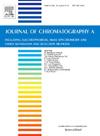静电排斥-亲水相互作用色谱法的肽保留时间预测。
IF 3.8
2区 化学
Q1 BIOCHEMICAL RESEARCH METHODS
引用次数: 0
摘要
静电斥力-亲水相互作用色谱法(ERLIC)是安德鲁-阿尔伯特博士开发的传统分离工具之一,一直用于开发包括肽在内的亲水性化合物的独特分离方法。过去,人们利用设计的肽库对其进行研究,以阐明其分离机制的主要特征,但仍缺乏针对 ERLIC 的全面的肽保留模型。在这项工作中,我们利用蛋白质组学衍生的 17 万个肽段保留数据集,在序列特异性保留计算模型的框架内评估了 ERLIC 的主要保留特征。对分离条件进行了调整,以获得更广泛的蛋白质组覆盖范围,特别是非修饰肽段,从而使二维液相色谱与反相 C18 LC-MS 在二维中的分离正交性更优越。SSRCalc ERLIC 模型与现有的 ERLIC 保留机制呈现出一致的主题,反映了肽的取向以及肽骨架上带电和亲水残基位置的依赖性。标准可解释 SSRCalc 模型和机器学习算法的 R2 值分别为 0.935 和 0.955。本研究评估了各种 PTM 对肽保留的影响,包括自发修饰(氧化、脱氨基)和酶修饰(N 端乙酰化、磷酸化、糖基化)。本文章由计算机程序翻译,如有差异,请以英文原文为准。
Peptide retention time prediction for electrostatic repulsion-hydrophilic interaction chromatography
Electrostatic Repulsion-Hydrophilic Interaction Chromatography (ERLIC) is one of the legacy separation tools developed by Dr. Andrew Alpert and has been used for developing unique separation methods of hydrophilic compounds, including peptides. In the past it has been studied using designed peptide libraries to elucidate major features of its separation mechanism, while comprehensive peptide retention modeling for ERLIC is still lacking. In this work we employed a proteomics-derived ∼170,000 peptide retention datasets to evaluate major ERLIC retention features using the framework of our Sequence-Specific Retention Calculator model. The separation conditions were adjusted to obtain a wider proteome coverage, particularly for non-modified peptides, resulting in a superior separation orthogonality for a 2D LC combination with reversed-phase C18 LC-MS in the second dimension. The SSRCalc ERLIC model presents a consistent theme with the existing ERLIC retention mechanism, reflecting a dependence on peptide orientation and the position of charged and hydrophilic residues across the peptide backbone. R2 values of 0.935 and 0.955 accuracy were demonstrated for the standard interpretable SSRCalc model and machine learning algorithm, respectively. The effects of various PTMs on peptide retention were evaluated in this study, covering spontaneous (oxidation, deamidation) and enzymatic (N-terminal acetylation, phosphorylation, glycosylation) modifications.
求助全文
通过发布文献求助,成功后即可免费获取论文全文。
去求助
来源期刊

Journal of Chromatography A
化学-分析化学
CiteScore
7.90
自引率
14.60%
发文量
742
审稿时长
45 days
期刊介绍:
The Journal of Chromatography A provides a forum for the publication of original research and critical reviews on all aspects of fundamental and applied separation science. The scope of the journal includes chromatography and related techniques, electromigration techniques (e.g. electrophoresis, electrochromatography), hyphenated and other multi-dimensional techniques, sample preparation, and detection methods such as mass spectrometry. Contributions consist mainly of research papers dealing with the theory of separation methods, instrumental developments and analytical and preparative applications of general interest.
 求助内容:
求助内容: 应助结果提醒方式:
应助结果提醒方式:


